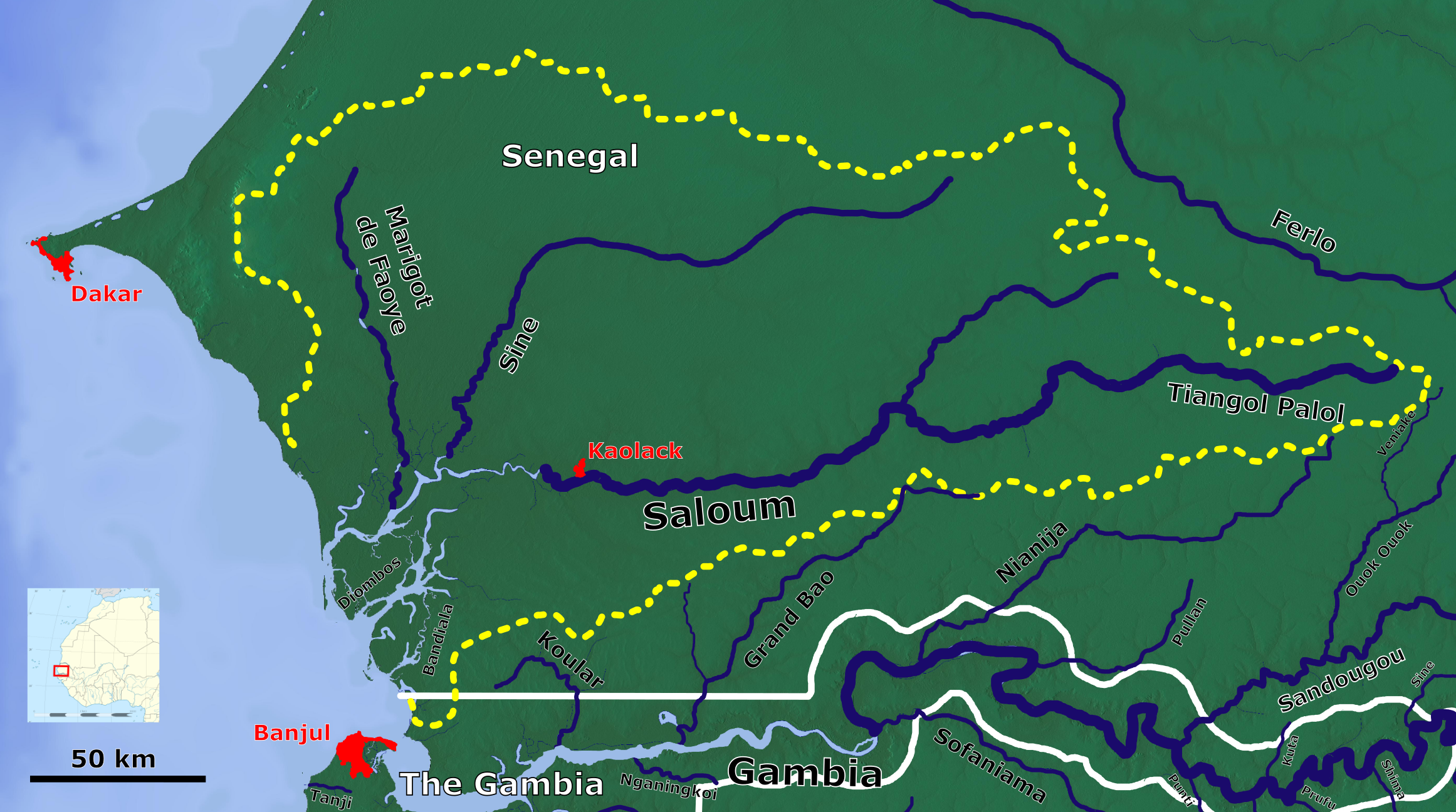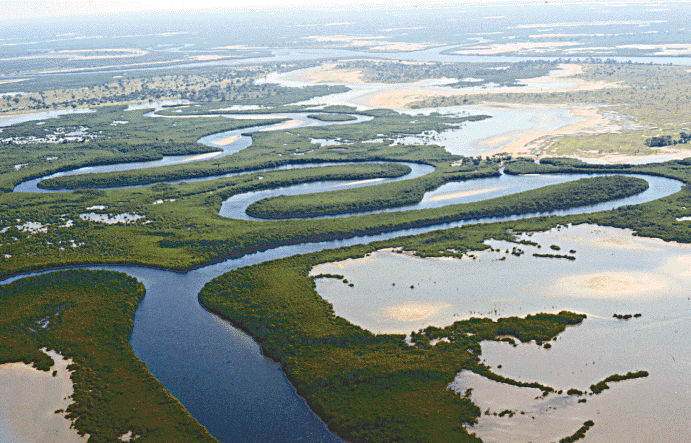|
Sine River
The River Sine or Sine River (Siin in Serer language) is a river in Senegal. It flows into the Atlantic Ocean with the River Saloum in the delta of Sine-Saloum. See also *Saloum Delta National Park, a UNESCO World Heritage site. *Saloum River *Sine-Saloum Sine-Saloum is a region in Senegal located north of the Gambia and south of the Petite Côte. It encompasses an area of 24,000 square kilometers, about 12% of Senegal, with a population in the 1990s of 1,060,000. The western portion contains the ... External links « Le pacte primordial dans la vallée du Sine »(articles n''Éthiopiques'' n° 31) Rivers of Senegal Serer holy places Serer country {{Senegal-river-stub ... [...More Info...] [...Related Items...] OR: [Wikipedia] [Google] [Baidu] |
Saloum OSM
The Kingdom of Saloum (Serer language: ''Saluum'' or ''Saalum'') was a Serer people, Serer/Wolof people, Wolof monarchy, kingdom in present-day Senegal. Its kings may have been of Mandinka people, Mandinka/Kaabu origin. The capital of Saloum was the city of Kahone. It was a sister kingdom of Sine. Their history, geography and culture were intricately linked and it was common to refer to them as the Sine-Saloum. History Saloum, just like its sister kingdom (the Kingdom of Sine), is known for its many ancient burial mounds or "tumuli" containing the graves of kings and others. The kingdom has numerous mysterious stone circles whose functions and history were unknown until recently. Historian Donald R. Wright states that "In the last decade of the fifteenth century, a group of nyancho lineages from Kaabu moved north of the Gambia River and took over an area on the southern edge of the weakening Jolof Empire. From a settlement near the mouth of the Saloum River, these lineages ... [...More Info...] [...Related Items...] OR: [Wikipedia] [Google] [Baidu] |
Serer Language
Serer, often broken into differing regional dialects such as Serer-Sine and Serer saloum, is a language of the kingdoms of Sine and Saloum branch of Niger–Congo spoken by 1.2 million people in Senegal and 30,000 in the Gambia as of 2009. It is the principal language of the Serer people. Classification Serer is one of the Senegambian languages, which are characterized by consonant mutation. The traditional classification of Atlantic is that of Sapir (1971), which found that Serer was closest to Fulani. However, a widely cited misreading of the data by Wilson (1989) inadvertently exchanged Serer for Wolof. Dialects of Serer are Serer Sine (the prestige dialect), Segum, Fadyut-Palmerin, Dyegueme (Gyegem), and Niominka. They are mutually intelligible except for the Sereer spoken in some of the areas surrounding the city of Thiès. Not all Serer people speak Serer. About 200,000 speak Cangin languages. Because the speakers are ethnically Serer, they are commonly thought to be S ... [...More Info...] [...Related Items...] OR: [Wikipedia] [Google] [Baidu] |
Senegal
Senegal,; Wolof: ''Senegaal''; Pulaar: 𞤅𞤫𞤲𞤫𞤺𞤢𞥄𞤤𞤭 (Senegaali); Arabic: السنغال ''As-Sinighal'') officially the Republic of Senegal,; Wolof: ''Réewum Senegaal''; Pulaar : 𞤈𞤫𞤲𞤣𞤢𞥄𞤲𞤣𞤭 𞤅𞤫𞤲𞤫𞤺𞤢𞥄𞤤𞤭 (Renndaandi Senegaali); Arabic: جمهورية السنغال ''Jumhuriat As-Sinighal'') is a country in West Africa, on the Atlantic Ocean coastline. Senegal is bordered by Mauritania to the north, Mali to the east, Guinea to the southeast and Guinea-Bissau to the southwest. Senegal nearly surrounds the Gambia, a country occupying a narrow sliver of land along the banks of the Gambia River, which separates Senegal's southern region of Casamance from the rest of the country. Senegal also shares a maritime border with Cape Verde. Senegal's economic and political capital is Dakar. Senegal is notably the westernmost country in the mainland of the Old World, or Afro-Eurasia. It owes its name to the ... [...More Info...] [...Related Items...] OR: [Wikipedia] [Google] [Baidu] |
Atlantic Ocean
The Atlantic Ocean is the second-largest of the world's five oceans, with an area of about . It covers approximately 20% of Earth's surface and about 29% of its water surface area. It is known to separate the " Old World" of Africa, Europe and Asia from the "New World" of the Americas in the European perception of the World. The Atlantic Ocean occupies an elongated, S-shaped basin extending longitudinally between Europe and Africa to the east, and North and South America to the west. As one component of the interconnected World Ocean, it is connected in the north to the Arctic Ocean, to the Pacific Ocean in the southwest, the Indian Ocean in the southeast, and the Southern Ocean in the south (other definitions describe the Atlantic as extending southward to Antarctica). The Atlantic Ocean is divided in two parts, by the Equatorial Counter Current, with the North(ern) Atlantic Ocean and the South(ern) Atlantic Ocean split at about 8°N. Scientific explorations of the A ... [...More Info...] [...Related Items...] OR: [Wikipedia] [Google] [Baidu] |
Saloum River
The Saloum River rises about 105 kilometers east of Kaolack, Senegal, and flows into the Atlantic Ocean. The significant Saloum Delta is located at its mouth, which is protected as Saloum Delta National Park. The river basin lies within the Serer people, Serer pre-colonial Saloum, Kingdom of Saloum. Mangrove forests occupy a 5-kilometer belt on either side of the river almost 70 kilometers upstream. See also *Sine River *Sine-Saloum *Kingdom of Saloum References A Directory of African Wetlands Robert Mepham, R. H. Hughes, G. M. Bernacsek, International Union for Conservation of Nature and Natural Resources, United Nations Environment Programme, World Conservation Monitoring Centre, 1992. Rivers of Senegal Serer country {{Senegal-river-stub ... [...More Info...] [...Related Items...] OR: [Wikipedia] [Google] [Baidu] |
Sine-Saloum
Sine-Saloum is a region in Senegal located north of the Gambia and south of the Petite Côte. It encompasses an area of 24,000 square kilometers, about 12% of Senegal, with a population in the 1990s of 1,060,000. The western portion contains the Saloum Delta, a river delta at the junction of the Saloum and the North Atlantic. It is in this region that the Saloum Delta National Park is located. 145,811 hectares of the Delta were designated a UNESCO Heritage Site in 2011. Because it flows so slowly, this delta allows saltwater to travel deep inland. Long ago, the Serer kingdoms of Sine and Saloum were rivals. In 1984, the area was divided into two administrative regions: Kaolack and Fatick. Regions of Senegal Economy Primary economic activities in the 2000s consisted of fishing, salt production, peanut farming, and millet farming. Transportation is difficult because of the many islands. A secondary economy is the construction of fishing boats. Ecosystem Much of the region c ... [...More Info...] [...Related Items...] OR: [Wikipedia] [Google] [Baidu] |
Saloum Delta National Park
Saloum Delta National Park or Parc National du Delta du Saloum in Senegal, is a national park. Established in 1976, it is situated within the Saloum Delta at the juncture of the Saloum River and the North Atlantic. The park, which forms part of a UNESCO World Heritage Site and a Ramsar Convention site, lies within a biosphere reserve. Water comprises of the park, intertidal mangroves and saltwater vegetation cover , and savannah and forest cover . It lies on the East Atlantic Flyway. The bird species that breed or winter in the area include royal tern, greater flamingo, Eurasian spoonbill, curlew sandpiper, ruddy turnstone, and little stint. This region represents an important synergy between nature with extensive biodiversity and the way of human development, which is still present, albeit fragile. Sustainable shellfish farming is highly developed here and is a very important source of food and export revenue for the local community and Senegal in general. The Saloum Delta ... [...More Info...] [...Related Items...] OR: [Wikipedia] [Google] [Baidu] |
UNESCO
The United Nations Educational, Scientific and Cultural Organization is a specialized agency of the United Nations (UN) aimed at promoting world peace and security through international cooperation in education, arts, sciences and culture. It has 193 member states and 12 associate members, as well as partners in the non-governmental, intergovernmental and private sector. Headquartered at the World Heritage Centre in Paris, France, UNESCO has 53 regional field offices and 199 national commissions that facilitate its global mandate. UNESCO was founded in 1945 as the successor to the League of Nations's International Committee on Intellectual Cooperation.English summary). Its constitution establishes the agency's goals, governing structure, and operating framework. UNESCO's founding mission, which was shaped by the Second World War, is to advance peace, sustainable development and human rights by facilitating collaboration and dialogue among nations. It pursues this objective t ... [...More Info...] [...Related Items...] OR: [Wikipedia] [Google] [Baidu] |
World Heritage
A World Heritage Site is a landmark or area with legal protection by an international convention administered by the United Nations Educational, Scientific and Cultural Organization (UNESCO). World Heritage Sites are designated by UNESCO for having cultural, historical, scientific or other form of significance. The sites are judged to contain "cultural and natural heritage around the world considered to be of outstanding value to humanity". To be selected, a World Heritage Site must be a somehow unique landmark which is geographically and historically identifiable and has special cultural or physical significance. For example, World Heritage Sites might be ancient ruins or historical structures, buildings, cities, deserts, forests, islands, lakes, monuments, mountains, or wilderness areas. A World Heritage Site may signify a remarkable accomplishment of humanity, and serve as evidence of our intellectual history on the planet, or it might be a place of great natural beauty. As ... [...More Info...] [...Related Items...] OR: [Wikipedia] [Google] [Baidu] |
Rivers Of Senegal
A river is a natural flowing watercourse, usually freshwater, flowing towards an ocean, sea, lake or another river. In some cases, a river flows into the ground and becomes dry at the end of its course without reaching another body of water. Small rivers can be referred to using names such as creek, brook, rivulet, and rill. There are no official definitions for the generic term river as applied to geographic features, although in some countries or communities a stream is defined by its size. Many names for small rivers are specific to geographic location; examples are "run" in some parts of the United States, "burn" in Scotland and northeast England, and "beck" in northern England. Sometimes a river is defined as being larger than a creek, but not always: the language is vague. Rivers are part of the water cycle. Water generally collects in a river from precipitation through a drainage basin from surface runoff and other sources such as groundwater recharge, springs, a ... [...More Info...] [...Related Items...] OR: [Wikipedia] [Google] [Baidu] |
Serer Holy Places
Serer may refer to: * Serer people * Serer language * Serer religion *Rafael Calvo Serer Rafael Calvo Serer (born 6 October 1916 at Valencia, Spain, died 19 April 1988 at Pamplona, Navarra, Spain) was a Professor of History of Spanish Philosophy, a writer, essayist. He was president of the Council of Administration of the newspaper ''M ... (1916-1988), Spanish historian {{disambig, surname Language and nationality disambiguation pages ... [...More Info...] [...Related Items...] OR: [Wikipedia] [Google] [Baidu] |




